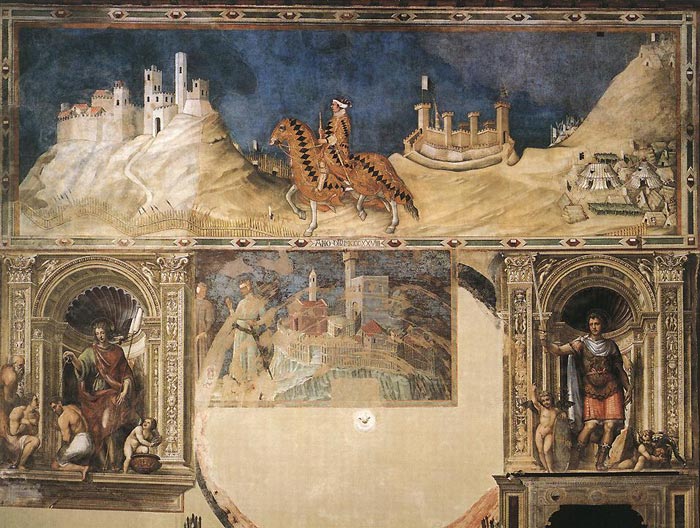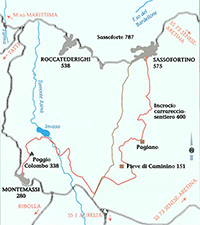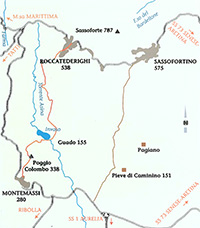 |
|
| N L |
Montemassi castle |
Montemassi |
Roccastrada and its territory are rich in fortresses and castles overlooking the plains of the Maremma. Not far from Roccastrada, near the village of Sassofortino, one can reach the ruins of a secluded castle. The castle of Montemassi is only few kilometres away from Sassofortino. The castle is, without any doubt, the most famous monument in the territory of Roccastrada. During the 13th century the castle belonged to the powerful Aldobrandeschi family and, between the numerous fortresses that they ruled in the Maremma, it was one of their main stronghold. In 1306 the castle wad subdued to the Pannocchieschi family that had numerous territories in the northwestern part of Tuscany. Later it passed to the Republic of Siena undergoing through the years, to a long series of destruction and rebuilding. |
Montemassi is home to the castle depicted in the Buon Governo painting by Simone Martini located in the Palazzo Pubblico of Siena.
|
 |
Simone Martini, Guidoriccio da Fogliano all'assedio di Montemassi, 1328, Siena, Palazzo Pubblico
|
For Gordon Moran, Michael Mallory, and others, the newly discovered fresco depicts Arcidosso, which, along with Castel del Piano, is documented as having been added to the castle series in 1331. Its structures and landscape resemble presentday Arcidosso exceptionally closely, and included as an additional identifying feature is a three-branched tree that leans out from the base of the keep, a device found in many of Arcidosso's town seals.
|
 |
| Unknown Master (first quarter of 14th century), Castle on a Hill, 1300-25, fresco in Palazzo Pubblico, Siena |
| The fresco of Guidoriccio da Fogliano, depicting the conquest of the castles of Montemassi and Sassoforte in 1328, formed part of a fresco cycle Castelli which occupied the upper part of the wall opposite to the Maestà in the Sala del Mappamondo in Palazzo Pubblico, in Siena. The cycle, commemorating the castles conquered by the Sienese, was initiated in 1314 by the representation of the Castle of Giuncarico, it was continued by the Guidoriccio and in 1331 by the Castles of Arcidosso and Piano. The latter were destroyed in 1361 when Lippo Vanni painted the Battles of Valdichiana and Poggio Imperiale. |
|||
|
|||
|
|||
Walking in Tuscany | Itineraries |
|||
The itinerary runs through one of the highest spurs in the entire area, the Sassoforte (787 mt). We commence our walk in Sassofortino and climb towards the Sassoforte, through chestnut trees and multi coloured prairies until we reach, at the foot of the mountain, one of the most beautiful beech tree forests in Tuscany, a wonderful forest where ancient beech trees grow from the clefts of volcanic rocks. |
|||
Sassofortino - Montemassi |15,8 Km, 5 hours |
|||
| We leave Sassofortino walking through small crops, Macchia, vineyards and pastures, an area rich in calcareous fossils where it is easy to find imprints of bivalves and gasteropoda where the fields are ploughed. In the whole area, especially on the highest part of the hill, huge oaks stand out on the fields. They were once very common, kept for their acorns and also for the precious shade they gave to the ploughmen when they rested. These oaks are nowadays cut down to give space to the work of tractors. We keep on walking through crops and woods of cork trees, to find ourselves in the Pagiano area where chestnut trees easily grow thanks to the presence of a plate of rhyolite, we then find holm trees and we get to the Pieve of Caminino. By the asphalted road there is the Oratory of Saint Feriolo, where it is said the Saint was martyred. Pilgrimage to this place only ended a few decades ago: people came in spring to pray that they would have plenty of water for they crops. Pilgrims would put an herring on the Saint painting, near his mouth so that it might recall him the idea of the refreshing water. We carry on crossing the asphalted road that leads to Sassofortino; we go through an under wood of cistus and lavender together with arbutus heather and huge cork trees. Going down to the dyke of the torrent Asina, we find the itinerary that comes from Roccatederighi, through Poggio Colombo we arrive in Montemassi. |
 |
||
| The Pieve di Caminino is situated to the east of the village of Montemassi. A medieval church, surrounded by a rural settlement, the Pieve di Caminino functioned as a religious building until the 17th century in which period the site was abandoned. In the latter half of the 1800's the Marucchi Locatelli family purchased the church and the surrounding buildings as well as the neighboring estate of Peruzzo. The various buildings were subsequently restored. The architecture of the ancient church is largely Romanesque in style and the higher section of the façade is still intact. Inside the church, which is no longer consecrated, concerts of classical music are held in virtue of the buildings perfect acoustics. |
|||
| Roccatederighi - Montemassi | 8,3 Km, 3 hours |
|||
| The first part of this itinerary goes through chestnut trees woods and crops going round the Rhyolitic spur on which Roccatederighi was built. In this part of the paths there is a botanical curiosity: the prickly broom (Ulex europaeus), which is not to be found anywhere else in our Municipality. Crops and olive trees becomes now predominant: they divide the land into small proprieties, giving the territory its characteristic aspect. We carry on towards the valley: behind us Roccatederighi’s church and the bell tower are easily spotted among the Rhyolitic rock spurs. We then get to the dyke of the torrent Asina and we take the gravel road leading to Montemassi. There are no more crops but woods of turkey oak, arbutus, heather and cystisus. Further up we can enjoy a wonderful view from two panoramic spots: the upper part of the road we are on from which we can see the village of Roccatederighi with the side of the mound sketched with edges, rows of olive trees surrounded by woods. The other spot is Poggio Colombo from which we can get a 360° view.
|
|||
|
|||
Montemassi
|
|||
|
|||
|
|||
Tenuta Rocca di Montemassi The museum is opened from Tuesday to Saturday, with timetable for the guided tours (visits last 1.5 hours): 10.30 a.m. – 2 p.m. – 4.30 p.m. Sundays and Holidays by appointment. |
|||


